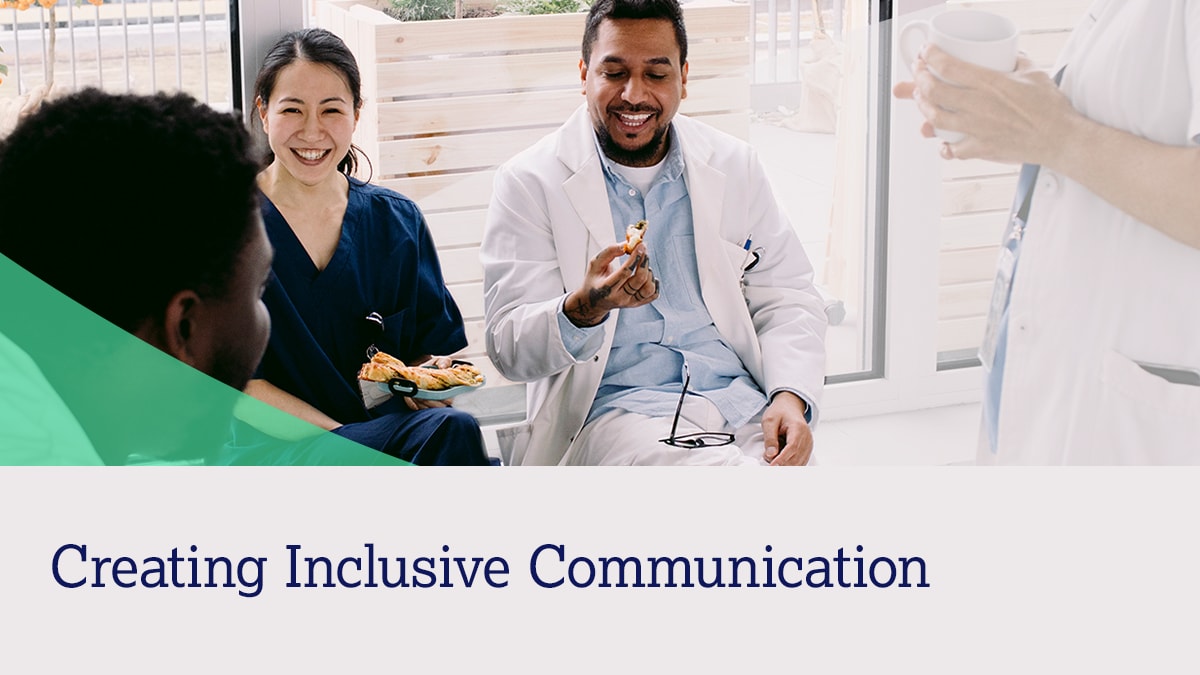At a glance
Use these tips to learn how to create inclusive communication to build a supportive and respectful workplace culture. This includes using images that reflect the diversity of your audience, tailoring messaging, and ensuring your communications are accessible for everyone.
Introduction
When developing communication products for your staff, keep diversity in mind to build a supportive, respectful, and inclusive workplace. Your hospital has people who work in many different roles. This includes clinicians, patient care technicians, facilities and custodial staff, administrators, and more. Each of those groups has specific language and work-related concerns that might not be understood or shared by others.
In addition, you should consider the cultural backgrounds and life experiences of your staff. These factors can bring additional layers of communication needs and preferences. The similarities and differences between groups can affect how they understand and respond to your message.

Inclusive workplace communication serves several purposes, including:
• Promoting a sense of trust and belonging among staff,
• Enhancing the effectiveness of your communication by ensuring that messages are clear and relevant to all, and
• Supporting staff wellbeing and psychological safety by creating an environment where everyone feels accepted and free to be themselves.1
Use the tips below to make your communication more inclusive.
Ensure diverse representation in your communication
Your materials should reflect the diversity of your audience. Include images, stories, and examples that represent various staff roles, personal identities, backgrounds, and experiences. This may include various roles, racial and ethnic communities, ages, genders, LGBTQ+ identities, and physical abilities.
Ideally, the team that develops your workplace communication should also reflect the diversity of your audience. This can help ensure your communication includes a range of identities and experiences and avoids stereotypes.
Use language that is respectful and inclusive
Consider how your words might be received by different communities and strive to create a welcoming and affirming message for all.2 Framing key messages with a "we/us" orientation, rather than only talking directly to your audience with "you" can help to increase feelings of community and inclusion.
Use gender-neutral language whenever possible. Avoid language that could stigmatize or marginalize individuals based on their identities, experiences, or conditions.
Tailor messages
When possible, tailor your messages for the audience(s) receiving each communication you create. Effective communication makes the recipients feel like it was designed just for them.
Not everybody will receive a message in the same way, depending on their professional background, life experiences, culture, language, and identity. This is especially true when talking about stigmatized topics like mental health. When language and imagery are intentionally inclusive, you increase the likelihood that your communication efforts will resonate with a broader audience.

Avoid assumptions and stereotypes
If the language or image(s) you use imply that everyone in a group shares similar characteristics, attitudes, or behaviors, some will feel excluded. For example, do not always depict or refer to doctors with male pronouns and nurses with female pronouns. Similarly, do not always depict families only as a traditional two-parent, heterosexual couple with children. Don’t assume limitations for people living with disabilities or mental health disorders.
Make your communication accessible to everyone
Make it easy for individuals with disabilities to receive and understand your communication. This includes people who are blind or have low vision, or people who are deaf or hard of hearing. To ensure that everyone can access and understand the information you are communicating:
- Use alternative formats, such as audio descriptions, captions, and screen reader compatibility.
- Use high-contrast colors, readable fonts, and accessible formatting in visual design.
Learn more
For more information and resources to help you develop accessible communication, visit Health Equity Guiding Principles for Inclusive Communication and Section508.gov.
- Centers for Disease Control and Prevention [2022]. Using a health equity lens. Atlanta, GA: Centers for Disease Control and Prevention.
- Centers for Disease Control and Prevention [2023]. Health equity guiding principles for inclusive communication. Atlanta, GA: Centers for Disease Control and Prevention.
